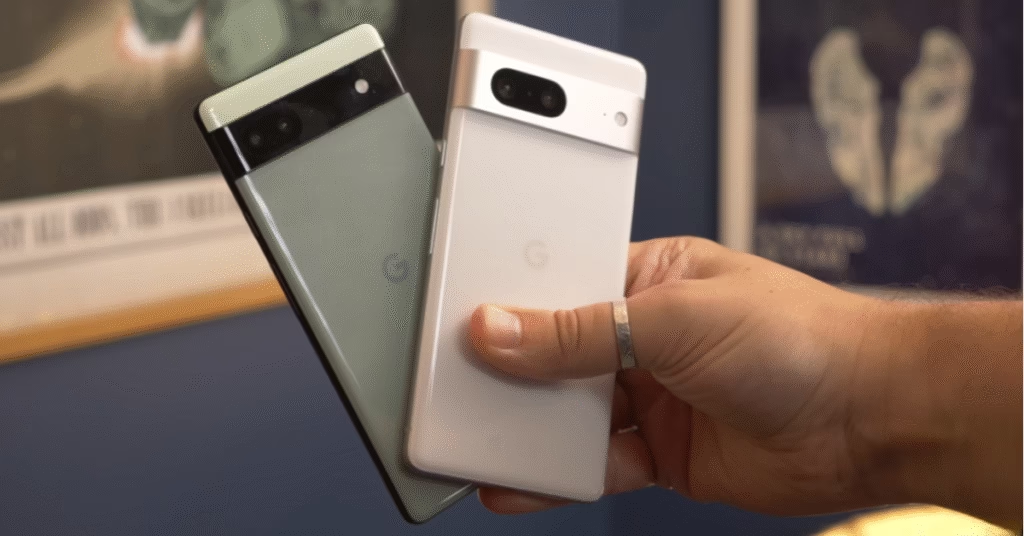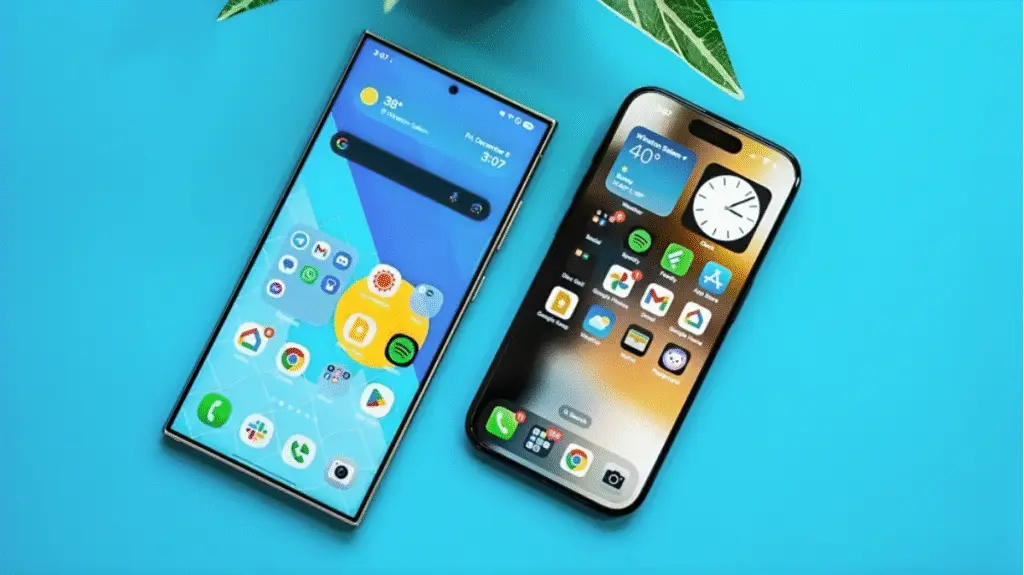
When Google first introduced the Pixel 6a, it quickly became one of the best mid-range phones around. Fast forward, and the Pixel 7 entered the scene with a few upgrades and a higher price tag. That naturally leads to one big question: is it really worth spending extra, or should you save some cash and stick with the cheaper model?
Let’s break it down and see how these two phones compare in design, display, performance, and camera the areas that matter most in daily use.
Design and Build Quality
Both phones share Google’s signature Pixel design language, a bold camera bar stretching across the back, clean lines, and slightly rounded corners. They clearly belong to the same family.
However, when you hold them side by side, you’ll notice differences right away. The Pixel 6a is smaller, lighter, and feels more compact in the hand. It’s easier to use one-handed, which makes it a great option for those who prefer a manageable size.
The Pixel 7, on the other hand, feels sturdier and more premium. Its aluminum camera bar not only looks stylish but also adds structural strength. The body is wrapped in Gorilla Glass Victus, giving it better protection from drops and scratches. The Pixel 6a’s plastic back keeps the weight down but doesn’t feel as luxurious.
Both phones come with solid water and dust resistance ratings IP68 for the Pixel 7 and IP67 for the Pixel 6a meaning either will survive a splash or two.
Overall, the 6a wins on portability, but the Pixel 7 feels like a true flagship in hand.
Display Experience
One of the more noticeable differences between these two phones is the display refresh rate. The Pixel 6a has a 60Hz panel, while the Pixel 7 steps up to a smoother 90Hz screen.
Now, that might not sound like a big deal on paper, but in practice, you can feel it. Scrolling through apps or swiping between screens on the Pixel 7 just feels more fluid. The 6a is perfectly fine for everyday tasks, but once you get used to a higher refresh rate, it’s hard to go back.
In terms of display quality, both have the same Full HD+ resolution and punchy colors, but the Pixel 7’s screen gets brighter and offers better contrast. HDR videos look more vivid, and outdoor visibility is noticeably improved. At 50% brightness, the Pixel 7’s panel feels livelier, while the 6a appears slightly muted.
So while the 6a’s display is perfectly adequate for the price, the Pixel 7 clearly delivers the richer, more premium visual experience.
Performance and Everyday Use
Under the hood, both phones are powered by Google’s Tensor chipset, though the Pixel 7 uses the updated Tensor G2 version. Despite that, everyday performance feels quite similar. Apps open quickly, multitasking is smooth, and both handle gaming without major hiccups.
Where you’ll notice a difference is in sustained performance and temperature control. The Pixel 6a tends to get warm faster, especially when gaming or recording videos for long periods. The Pixel 7 stays cooler and seems better optimized for demanding tasks.
That smoother 90Hz display also contributes to a feeling of speed. The Pixel 7 isn’t necessarily faster in raw numbers, but it feels faster because everything glides more naturally on screen.
In short, both are capable, but the Pixel 7 holds up better during longer sessions.
Battery Life
Battery life is surprisingly close between these two models. The Pixel 6a packs a 4410mAh cell, while the Pixel 7 has a slightly smaller 4355mAh unit. In real-world use, both comfortably last a full day on a single charge.
During mixed use a few hours of social media, some gaming, photos, and streaming both phones typically end the day with around 30% battery left.
Charging speeds are also similar, though the Pixel 7 adds wireless charging, something missing from the 6a. For many, that might be a small but appreciated convenience.
Camera Comparison
This is where Google phones usually shine, and both devices live up to the brand’s photography reputation.
In good lighting, the results from both cameras are impressive, but the Pixel 7 has a few clear advantages. Its main sensor has a wider field of view, capturing more of the scene in each shot. Colors and exposure look slightly more balanced, with brighter highlights and less harsh contrast.
The Pixel 6a still delivers that classic Pixel look detailed shots with deep contrast but it leans a bit darker. The Pixel 7, thanks to its upgraded processing, draws in more light and produces more accurate tones.
Zooming is another area where the Pixel 7 takes the lead. It offers digital zoom up to 8x, compared to the 6a’s 2x limit. Even at moderate zoom levels, the 7 holds on to more detail.
When the sun goes down, the difference grows wider. The Pixel 7’s improved low-light processing captures more detail in shadows and produces cleaner night shots. It also shoots faster in dark environments, reducing blur from shaky hands.
For video, the Pixel 7 supports 10-bit HDR and a cinematic mode, though the latter still feels experimental. Edge detection can be inconsistent, but it’s a fun feature for creative users.
In short, the Pixel 7’s camera system feels more complete, but the 6a still punches well above its price range.
Software and Longevity
Both phones run clean, feature-rich Android software with Google’s signature experience. You’ll get five years of security updates and at least three major Android OS updates on both devices.
The Pixel 7, being newer, will naturally receive updates for a bit longer, but both are well-supported in the long term.
You also get exclusive features like Magic Eraser, Live Transcribe, and Google’s adaptive AI that learns your habits over time all running smoothly on either phone.
Verdict: Which One Should You Get?
After spending time with both, it’s clear that you get what you pay for. The Pixel 7 is better built, smoother, brighter, and equipped with a more capable camera system. It feels like a polished flagship in every sense.
However, the Pixel 6a remains one of the best mid-range phones you can buy. It delivers reliable performance, solid cameras, and great battery life for a much lower price.
If budget isn’t a big concern and you want that premium feel, the Pixel 7 is the obvious choice. But if you’re looking for value without sacrificing much, the Pixel 6a is still an incredible deal especially now that it’s often discounted.
In the battle of Google Pixel 7 vs 6a, the winner really depends on your priorities: refinement and premium touches, or simplicity and savings. Either way, you’re getting a phone that delivers the best of Google’s Android experience.
See Also Pixel 6 Pro vs Pixel 9 Pro XL: A Clear Evolution, Not Just an Upgrade
FAQs
Which phone is faster: the Pixel 7 or Pixel 6a?
The Pixel 7 runs on Google’s Tensor G2 chip, making it slightly faster and more efficient than the Pixel 6a’s first-generation Tensor processor. In daily use, the difference isn’t huge, but the Pixel 7 handles multitasking and gaming better.
Is the Pixel 7 camera better than the Pixel 6a?
Yes. While both deliver excellent photos, the Pixel 7 has a more advanced main sensor, improved night photography, and better image processing. It also supports features like Cinematic Blur for video, which the 6a doesn’t have.
Does the Pixel 6a have wireless charging?
No, the Pixel 6a doesn’t support wireless charging. The Pixel 7 does, which adds more convenience for users who prefer cable-free charging.
Which phone has better battery life?
Battery life is similar on both, but the Pixel 6a can sometimes last longer because of its smaller, lower-resolution display. However, the Pixel 7 supports faster charging and better battery optimization.
Are both phones getting Android updates for the same duration?
Yes, both are promised up to five years of security updates. However, since the Pixel 7 is a newer release, it will receive one extra year of Android OS updates compared to the 6a.
Is the Pixel 7 display better than the Pixel 6a?
Absolutely. The Pixel 7 features a brighter, smoother 90Hz OLED display, while the Pixel 6a is limited to 60Hz. The difference is noticeable when scrolling or gaming.
Should I upgrade from Pixel 6a to Pixel 7?
If you value better performance, smoother display, and improved camera quality, upgrading makes sense. But if your 6a still feels snappy and you’re happy with its battery life, it remains a great value phone.
